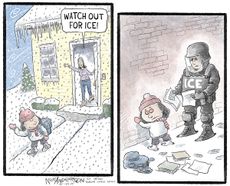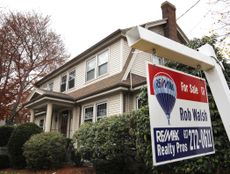The mortgage pain point
And more of the week’s best financial advice

Here are three of the week's top pieces of financial advice, gathered from around the web:
The mortgage pain point
Interest rates on the most common type of mortgage topped 5 percent last week for the first time since January 2011, said Wolf Richter at WolfStreet, and another point higher will hit the "pain threshold" for the housing market. Thirty-year fixed rates for "conforming loans" — mortgages for single family homes priced below $453,100, with a 20 percent down payment — are now at 5.05 percent, up from below 4 percent in 2016. While that's still a historically low number, it's likely to rise as the Federal Reserve steadily lifts the interest rate it charges to banks. A 6 percent rate would take mortgages close to where they stood in the housing bubble. That "will block a considerable number of potential buyers from buying at current prices." Cities where prices have "surged" as much as 55 percent from their housing bubble peak — including Seattle, San Francisco, and Denver — could be hit particularly hard.
Subscribe to The Week
Escape your echo chamber. Get the facts behind the news, plus analysis from multiple perspectives.

Sign up for The Week's Free Newsletters
From our morning news briefing to a weekly Good News Newsletter, get the best of The Week delivered directly to your inbox.
From our morning news briefing to a weekly Good News Newsletter, get the best of The Week delivered directly to your inbox.
Child care for Starbucks workers
Starbucks this week began providing its employees with 10 days a year of heavily subsidized backup child and senior care, said Benjamin Romano at The Seattle Times. If an employee's child care falls through — if school is canceled, for example — the worker can put a child in a day-care center for $5 a day, or hire in-home care for $1 an hour. Starbucks says the program will help its 180,000 U.S. employees "come to work with fewer worries." Many companies have cut child-care benefits over the past 20 years: only 3 percent of employers now offer subsidized child-care centers, down from 9 percent in 1996.
Hailing a hospital ride
Ride-hailing services could help shrink the $14 billion a year that Americans spend on ambulance rides, said Austin Frakt at The New York Times. A trip in an ambulance can cost thousands of dollars, "and a lot of it may not be covered by insurance." Studies also find that nearly a third of rides are inappropriate — ambulances cart many people with minor injuries. For nonemergency medical transportation, Uber and Lyft might be a better and cheaper option. Both companies now offer services that let health-care providers order rides for patients. Or you could hail a car with your own app. "An advantage of arranging your own ride is that you can direct it to a hospital or doctor's office of your choosing." Ambulances only take patients to hospitals "and typically to the nearest one."
Sign up for Today's Best Articles in your inbox
A free daily email with the biggest news stories of the day – and the best features from TheWeek.com
-
 Judge pauses Trump's birthright citizenship ban
Judge pauses Trump's birthright citizenship banSpeed Read A federal judge in Seattle temporarily blocked President Donald Trump's 'unconstitutional' executive order to overturn birthright citizenship
By Rafi Schwartz, The Week US Published
-
 Today's political cartoons - January 24, 2025
Today's political cartoons - January 24, 2025Cartoons Friday's cartoons - ice cold, now you see it, and more
By The Week US Published
-
 Why are we so obsessed with The Traitors?
Why are we so obsessed with The Traitors?In the Spotlight It's the BBC's most scheming, manipulative and treacherous show – and viewers can't get enough
By Elizabeth Carr-Ellis, The Week UK Published
-
 The pros and cons of noncompete agreements
The pros and cons of noncompete agreementsThe Explainer The FTC wants to ban companies from binding their employees with noncompete agreements. Who would this benefit, and who would it hurt?
By Peter Weber Published
-
 What experts are saying about the economy's surprise contraction
What experts are saying about the economy's surprise contractionThe Explainer The sharpest opinions on the debate from around the web
By Brendan Morrow Published
-
 The death of cities was greatly exaggerated
The death of cities was greatly exaggeratedThe Explainer Why the pandemic predictions about urban flight were wrong
By David Faris Published
-
 The housing crisis is here
The housing crisis is hereThe Explainer As the pandemic takes its toll, renters face eviction even as buyers are bidding higher
By The Week Staff Published
-
 How to be an ally to marginalized coworkers
How to be an ally to marginalized coworkersThe Explainer Show up for your colleagues by showing that you see them and their struggles
By Tonya Russell Published
-
 What the stock market knows
What the stock market knowsThe Explainer Publicly traded companies are going to wallop small businesses
By Noah Millman Published
-
 Can the government save small businesses?
Can the government save small businesses?The Explainer Many are fighting for a fair share of the coronavirus rescue package
By The Week Staff Published
-
 How the oil crash could turn into a much bigger economic shock
How the oil crash could turn into a much bigger economic shockThe Explainer This could be a huge problem for the entire economy
By Jeff Spross Published